A Review on Navigating Sustainable Naval Design: LCA and Innovations in Energy and Fuel Choices
Abstract
:1. Introduction
1.1. Overview
1.2. Scope
1.3. Outline
2. Method
3. Outcomes from the Literature Review
3.1. Articles Description
3.2. Emission Normalization
4. Results and Discussions
5. Conclusions
Author Contributions
Funding
Informed Consent Statement
Data Availability Statement
Conflicts of Interest
Nomenclature
| Full Name | Nomenclature |
| Carbon Capture and Storage | CCS |
| Carbon Intensity Indicator | CII |
| Carbon Monoxide | CO |
| Centrum voor Milieuwetenschappen Leiden | CML |
| Cradle to Grave | CtG |
| Crude Palm Oil | CPO |
| Dimethyl Ether | DME |
| Energy Efficiency Design Index | EEDI |
| Energy Efficiency Existing Ships Index | EEXI |
| European Union | EU |
| Global Warming Potential | GWP |
| Greenhouse Gases | GHG |
| Heavy Fuel Oil | HFO |
| High-Sulfur Fuel Oil | HSFO |
| International Reference LifeCycle Data system | ILCD |
| International Maritime Organization | IMO |
| Intergovernmental Panel on Climate Change | IPCC |
| Life-Cycle Assessment | LCA |
| Life-Cycle Impact Assessment | LCIA |
| Life-Cycle Inventory analysis | LCI |
| Liquefied Natural Gas | LNG |
| Liquefied Petroleum Gas | LPG |
| Low-Sulfur Heavy Fuel Oil | LSHFO |
| Low-Sulfur Petroleum Diesel | LSPD |
| Low-Sulfur Diesel | LSD |
| Marine Diesel Oil | MDO |
| Marine Gas Oil | MGO |
| Natural Gas | NG |
| Non-Methane Volatile Organic Compounds | NMVOC |
| Not Available | N.A. |
| Refined, Bleached, and Deodorized | RBD |
| Steam Methane Reforming | SMR |
| Straight Vegetable Oil | SVO |
| Tank to Wake | TtW |
| Tool for the Reduction and Assessment of Chemical and other environmental Impacts | TRACI |
| Ultra-Low-Sulfur Fuel Oil | ULSFO |
| Volatile Organic Compounds | VOC |
| Well to Tank | WtT |
| Well to Wake | WtW |
References
- Yu, J.Y.; Sghaier, M.O.; Grabowiecka, Z. Deep Learning Approaches for AIS Data Association in the Context of Maritime Domain Awareness. In Proceedings of the 2020 IEEE 23rd International Conference on Information Fusion, Rustenburg, South Africa, 6–9 July 2020. [Google Scholar] [CrossRef]
- Wang, S.; Wang, X.; Han, Y.; Wang, X.; Jiang, H.; Duan, J.; Hua, R.; Zhang, Z. Decarbonizing in Maritime Transportation: Challenges and Opportunities. J. Transp. Technol. 2023, 13, 301–325. [Google Scholar] [CrossRef]
- Čampara, L.; Hasanspahić, N.; Vujičić, S. Overview of MARPOL ANNEX VI Regulations for Prevention of Air Pollution from Marine Diesel Engines. SHS Web Conf. 2018, 58, 01004. [Google Scholar] [CrossRef]
- Iannaccone, T.; Landucci, G.; Tugnoli, A.; Salzano, E.; Cozzani, V. Sustainability of Cruise Ship Fuel Systems: Comparison among LNG and Diesel Technologies. J. Clean. Prod. 2020, 260, 121069. [Google Scholar] [CrossRef]
- Thomson, H.; Corbett, J.J.; Winebrake, J.J. Natural Gas as a Marine Fuel. Energy Policy 2015, 87, 153–167. [Google Scholar] [CrossRef]
- Kołwzan, K. Life Cycle Assessment of the Alternative Fuels in the Light of the International Maritime Organization Initial GHG Reduction Strategy. Prawo Morskie 2022, XLIII, 59–78. [Google Scholar] [CrossRef]
- Horvath, S.; Fasihi, M.; Breyer, C. Techno-Economic Analysis of a Decarbonized Shipping Sector: Technology Suggestions for a Fleet in 2030 and 2040. Energy Convers. Manag. 2018, 164, 230–241. [Google Scholar] [CrossRef]
- Zhang, S.; Li, Y.; Yuan, H.; Sun, D. An Alternative Benchmarking Tool for Operational Energy Efficiency of Ships and Its Policy Implications. J. Clean. Prod. 2019, 240, 118223. [Google Scholar] [CrossRef]
- Lee, S.S. Analysis of the Effects of EEDI and EEXI Implementation on CO2 Emissions Reduction in Ships. Ocean Eng. 2024, 295, 116877. [Google Scholar] [CrossRef]
- Bayraktar, M.; Yuksel, O. A Scenario-Based Assessment of the Energy Efficiency Existing Ship Index (EEXI) and Carbon Intensity Indicator (CII) Regulations. Ocean Eng. 2023, 278, 114295. [Google Scholar] [CrossRef]
- Polakis, M.; Zachariadis, P.; de Kat, J.O. The Energy Efficiency Design Index (EEDI) BT—Sustainable Shipping: A Cross-Disciplinary View; Psaraftis, H.N., Ed.; Springer International Publishing: Cham, Switzerland, 2019; pp. 93–135. ISBN 978-3-030-04330-8. [Google Scholar]
- Ivanova, G. Analysis of the Specifics in Calculating the Index of Existing Marine Energy Efficiency EEXI in Force since 2023. In Proceedings of the 2021 13th Electrical Engineering Faculty Conference (BulEF), Varna, Bulgaria, 8–11 September 2021; pp. 1–4. [Google Scholar] [CrossRef]
- Yuan, Q.; Wang, S.; Peng, J. Operational Efficiency Optimization Method for Ship Fleet to Comply with the Carbon Intensity Indicator (CII) Regulation. Ocean Eng. 2023, 286, 115487. [Google Scholar] [CrossRef]
- Strantzali, E.; Livanos, G.A.; Aravossis, K. A Comprehensive Multicriteria Evaluation Approach for Alternative Marine Fuels. Energies 2023, 16, 498. [Google Scholar] [CrossRef]
- Maritime Forecast to 2050. Available online: https://www.dnv.com/maritime/publications/maritime-forecast-2023/index.html (accessed on 1 January 2024).
- ISO 14040:2021; Environmental Management—Life Cycle Assessment—Principles and Framework. ISO: Geneva, Switzerland, 2021.
- ISO 14044:2021; Environmental Management—Life Cycle Assessment—Requirements and Guidelines. ISO: Geneva, Switzerland, 2021.
- Mohammad, A.K.; Sumeray, C.; Richmond, M.; Hinshelwood, J.; Ghosh, A. Assessing the Sustainability of Liquid Hydrogen for Future Hypersonic Aerospace Flight. Aerospace 2022, 9, 801. [Google Scholar] [CrossRef]
- Di Bella, G.; Alderucci, T.; Salmeri, F.; Cucinotta, F. Integrating the Sustainability Aspects into the Risk Analysis for the Manufacturing of Dissimilar Aluminium/Steel Friction Stir Welded Single Lap Joints Used in Marine Applications through a Life Cycle Assessment. Sustain. Futur. 2022, 4, 100101. [Google Scholar] [CrossRef]
- Cucinotta, F.; Raffaele, M.; Salmeri, F. A Well-to-Wheel Comparative Life Cycle Assessment between Full Electric and Traditional Petrol Engines in the European Context. In Advances on Mechanics, Design Engineering and Manufacturing III; Roucoules, L., Paredes, M., Eynard, B., Morer Camo, P., Rizzi, C., Eds.; Springer International Publishing: Cham, Switzerland, 2021; pp. 188–193. [Google Scholar]
- Deepak, A.; Sharma, V.; Kumar, D. Life Cycle Assessment of Biomedical Waste Management for Reduced Environmental Impacts. J. Clean. Prod. 2022, 349, 131376. [Google Scholar] [CrossRef]
- Codotto, G.; Pizzol, M.; Hegland, T.J.; Madsen, N. Model Uncertainty versus Variability in the Life Cycle Assessment of Commercial Fisheries. J. Ind. Ecol. 2024, 28, 160–172. [Google Scholar] [CrossRef]
- Sandison, F.; Hillier, J.; Hastings, A.; Macdonald, P.; Mouat, B.; Marshall, C.T. The Environmental Impacts of Pelagic Fish Caught by Scottish Vessels. Fish. Res. 2021, 236, 105850. [Google Scholar] [CrossRef]
- Ramos, S.; Vázquez-Rowe, I.; Artetxe, I.; Moreira, M.T.; Feijoo, G.; Zufía, J. Environmental Assessment of the Atlantic Mackerel (Scomber scombrus) Season in the Basque Country. Increasing the Timeline Delimitation in Fishery LCA Studies. Int. J. Life Cycle Assess. 2011, 16, 599–610. [Google Scholar] [CrossRef]
- Hospido, A.; Tyedmers, P. Life Cycle Environmental Impacts of Spanish Tuna Fisheries. Fish. Res. 2005, 76, 174–186. [Google Scholar] [CrossRef]
- Vázquez-Rowe, I.; Moreira, M.T.; Feijoo, G. Life Cycle Assessment of Horse Mackerel Fisheries in Galicia (NW Spain): Comparative Analysis of Two Major Fishing Methods. Fish. Res. 2010, 106, 517–527. [Google Scholar] [CrossRef]
- Almeida, C.; Vaz, S.; Cabral, H.; Ziegler, F. Environmental Assessment of Sardine (Sardina pilchardus) Purse Seine Fishery in Portugal with LCA Methodology Including Biological Impact Categories. Int. J. Life Cycle Assess. 2014, 19, 297–306. [Google Scholar] [CrossRef]
- Villanueva-Rey, P.; Vázquez-Rowe, I.; Arias, A.; Moreira, M.T.; Feijoo, G. The Importance of Using Life Cycle Assessment in Policy Support to Determine the Sustainability of Fishing Fleets: A Case Study for the Small-Scale Xeito Fishery in Galicia, Spain. Int. J. Life Cycle Assess. 2018, 23, 1091–1106. [Google Scholar] [CrossRef]
- Almeida, C.; Loubet, P.; Laso, J.; Nunes, M.L.; Marques, A. Environmental Assessment of Common Octopus (Octopus vulgaris) from a Small-Scale Fishery in Algarve (Portugal). Int. J. Life Cycle Assess. 2022, 27, 849–867. [Google Scholar] [CrossRef]
- Avadí, A.A.; Adrien, R.; Aramayo, V.; Fréon, P.; Avadí, A.A.; Adrien, R.; Aramayo, V.; Fréon, P. Environmental Assessment of the Peruvian Industrial Hake Fishery with LCA To Cite This Version: HAL Id: Hal-01824165 Environmental Assessment of the Peruvian Industrial Hake Fishery with LCA. Int. J. Life Cycle Assess. 2023, 23, 1126–1140. [Google Scholar] [CrossRef]
- Cucinotta, F.; Guglielmino, E.; Sfravara, F. Life Cycle Assessment in Yacht Industry: A Case Study of Comparison between Hand Lay-up and Vacuum Infusion. J. Clean. Prod. 2017, 142, 3822–3833. [Google Scholar] [CrossRef]
- Önal, M. Evaluation of Shipyard Operation Processes with Cradle-to-Gate Life Cycle Assessment Based on Material Consumption Rates for an Aluminum and Steel Yacht. Ships Offshore Struct. 2023, 18, 1–7. [Google Scholar] [CrossRef]
- Önal, M.; Neşer, G.; Gürsel, K.T. Environmental Impacts of Steel Ship Hulls Building and Recycling by Life Cycle Assessment (LCA). Ships Offshore Struct. 2021, 16, 1061–1066. [Google Scholar] [CrossRef]
- Quang, P.K.; Dong, D.T.; Hai, P.T.T. Evaluating Environmental Impacts of an Oil Tanker Using Life Cycle Assessment Method. Proc. Inst. Mech. Eng. Part M J. Eng. Marit. Environ. 2021, 235, 705–717. [Google Scholar] [CrossRef]
- Burman, M.; Kuttenkeuler, J.; Stenius, I.; Garme, K.; Rosén, A. Comparative Life Cycle Assessment of the Hull of a High-Speed Craft. Proc. Inst. Mech. Eng. Part M J. Eng. Marit. Environ. 2015, 230, 378–387. [Google Scholar] [CrossRef]
- Kramel, D.; Muri, H.; Kim, Y.; Lonka, R.; Nielsen, J.B.; Ringvold, A.L.; Bouman, E.A.; Steen, S.; Strømman, A.H. Global Shipping Emissions from a Well-to-Wake Perspective: The MariTEAM Model. Environ. Sci. Technol. 2021, 55, 15040–15050. [Google Scholar] [CrossRef] [PubMed]
- Di Lullo, G.; Zhang, H.; Kumar, A. Evaluation of Uncertainty in the Well-to-Tank and Combustion Greenhouse Gas Emissions of Various Transportation Fuels. Appl. Energy 2016, 184, 413–426. [Google Scholar] [CrossRef]
- Del Pero, F.; Dattilo, C.A.; Giraldi, A.; Delogu, M. LCA Approach for Environmental Impact Assessment within the Maritime Industry: Re-Design Case Study of Yacht’s Superstructure. Proc. Inst. Mech. Eng. Part M J. Eng. Marit. Environ. 2023, 238, 153–170. [Google Scholar] [CrossRef]
- Guinée, J. Handbook on Life Cycle Assessment—Operational Guide to the ISO Standards. Int. J. Life Cycle Assess. 2001, 6, 255. [Google Scholar] [CrossRef]
- Huijbregts, M.A.J.; Steinmann, Z.J.N.; Elshout, P.M.F.; Stam, G.; Verones, F.; Vieira, M.; Zijp, M.; Hollander, A.; van Zelm, R. ReCiPe2016: A Harmonised Life Cycle Impact Assessment Method at Midpoint and Endpoint Level. Int. J. Life Cycle Assess. 2017, 22, 138–147. [Google Scholar] [CrossRef]
- Joint Research Centre; Institute for Environment and Sustainability. International Reference Life Cycle Data System (ILCD) Handbook—General Guide for Life Cycle Assessment—Detailed Guidance; Publications Office: Luxembourg, 2010. [Google Scholar]
- Ryberg, M.; Vieira, M.D.M.; Zgola, M.; Bare, J.; Rosenbaum, R.K. Updated US and Canadian Normalization Factors for TRACI 2.1. Clean Technol. Environ. Policy 2014, 16, 329–339. [Google Scholar] [CrossRef]
- Seppala, J.; Risbey, J.; Meilinger, S.; Norris, G.; Lindfors, G.L.; Goedkoop, M. Best Available Practice in Life Cycle Assessment Ofclimate Change, Stratospheric Ozone Depletion, Photo-Oxidant Formation, Acidification, and Eutrophication-Backgroundson General Issues; Rijksinstituut voor Volksgezondheid en Milieu RIVM: Bilthoven, The Netherlands, 2001. [Google Scholar]
- UNEP; WMO. Intergovernmental Panel on Climate Change. In Proceedings of the Report of the 21st Session of the IPCC, Vienna, Austria, 3 and 6–7 November 2003. [Google Scholar]
- Guinée, J.; Heijungs, R. A Proposal for the Classification of Toxic Substances within the Framework of Life Cycle Assessment of Products. Chemosphere 1993, 26, 1925–1944. [Google Scholar] [CrossRef]
- Hertwich, E.G.; Mateles, S.F.; Pease, W.S.; McKone, T.E. Human Toxicity Potentials for Life-Cycle Assessment and Toxics Release Inventory Risk Screening. Environ. Toxicol. Chem. 2001, 20, 928–939. [Google Scholar] [CrossRef]
- Rosenbaum, R.K. Ecotoxicity BT—Life Cycle Impact Assessment; Hauschild, M.Z., Huijbregts, M.A.J., Eds.; Springer: Dordrecht, The Netherlands, 2015; pp. 139–162. ISBN 978-94-017-9744-3. [Google Scholar]
- Morelli, B.; Hawkins, T.R.; Niblick, B.; Henderson, A.D.; Golden, H.E.; Compton, J.E.; Cooter, E.J.; Bare, J.C. Critical Review of Eutrophication Models for Life Cycle Assessment. Environ. Sci. Technol. 2018, 52, 9562–9578. [Google Scholar] [CrossRef]
- Struijs, J.; Beusen, A.; van Jaarsveld, H.; Huijbregts, M.A.J. Eutrophication. In ReCiPe 2008; Goedkoop, M., Heijungs, R., Huijbregts, M.A.J., De Schryver, A., Struijs, J., van Zelm, R., Eds.; Ministry of Housing, Spatial Planning and the Environmen: The Hague, The Netherlands, 2009. [Google Scholar]
- Bouwman, A.F.; Van Vuuren, D.P.; Derwent, R.G.; Posch, M. A Global Analysis of Acidification and Eutrophication of Terrestrial Ecosystems. Water Air Soil Pollut. 2002, 141, 349–382. [Google Scholar] [CrossRef]
- Posch, M.; Seppälä, J.; Hettelingh, J.-P.; Johansson, M.; Margni, M.; Jolliet, O. The Role of Atmospheric Dispersion Models and Ecosystem Sensitivity in the Determination of Characterisation Factors for Acidifying and Eutrophying Emissions in LCIA. Int. J. Life Cycle Assess. 2008, 13, 477–486. [Google Scholar] [CrossRef]
- Bach, V.; Möller, F.; Finogenova, N.; Emara, Y.; Finkbeiner, M. Characterization Model to Assess Ocean Acidification within Life Cycle Assessment. Int. J. Life Cycle Assess. 2016, 21, 1463–1472. [Google Scholar] [CrossRef]
- Payen, S.; Ledgard, S.F. Aquatic Eutrophication Indicators in LCA: Methodological Challenges Illustrated Using a Case Study in New Zealand. J. Clean. Prod. 2017, 168, 1463–1472. [Google Scholar] [CrossRef]
- Morales-Méndez, J.D.; Silva-Rodríguez, R. Environmental Assessment of Ozone Layer Depletion Due to the Manufacture of Plastic Bags. Heliyon 2018, 4, e01020. [Google Scholar] [CrossRef]
- Trillos, J.C.G.; Wilken, D.; Brand, U.; Vogt, T. Correction to: Life Cycle Assessment of a Hydrogen and Fuel Cell RoPax Ferry Prototype; Springer International Publishing: Cham, Switzerland, 2021; ISBN 9783030505196. [Google Scholar]
- Kanchiralla, F.M.; Brynolf, S.; Malmgren, E.; Hansson, J.; Grahn, M. Life-Cycle Assessment and Costing of Fuels and Propulsion Systems in Future Fossil-Free Shipping. Environ. Sci. Technol. 2022, 56, 12517–12531. [Google Scholar] [CrossRef]
- Wang, H.; Boulougouris, E.; Theotokatos, G.; Priftis, A.; Shi, G.; Zhou, P. A Comparative Life Cycle Assessment Study on Environmental Performances between Battery-Powered and Conventional Marine Vessels. In Maritime Technology and Engineering 5 Volume 1, Proceedings of the 5th International Conference on Maritime Technology and Engineering (MARTECH 2020), Lisbon, Portugal, 16–19 November 2020; CRC Press: London, UK, 2021; Volume 1, pp. 119–126. [Google Scholar] [CrossRef]
- Zincir, B.A.; Arslanoglu, Y. Comparative Life Cycle Assessment of Alternative Marine Fuels. Fuel 2024, 358, 129995. [Google Scholar] [CrossRef]
- Seyam, S.; Dincer, I.; Agelin-Chaab, M. Exergoeconomic and Exergoenvironmental Analyses of a Potential Marine Engine Powered by Eco-Friendly Fuel Blends with Hydrogen. Energy 2023, 284, 129276. [Google Scholar] [CrossRef]
- Bicer, Y.; Dincer, I. Environmental Impact Categories of Hydrogen and Ammonia Driven Transoceanic Maritime Vehicles: A Comparative Evaluation. Int. J. Hydrogen Energy 2018, 43, 4583–4596. [Google Scholar] [CrossRef]
- Fernández-Ríos, A.; Santos, G.; Pinedo, J.; Santos, E.; Ruiz-Salmón, I.; Laso, J.; Lyne, A.; Ortiz, A.; Ortiz, I.; Irabien, Á.; et al. Environmental Sustainability of Alternative Marine Propulsion Technologies Powered by Hydrogen—A Life Cycle Assessment Approach. Sci. Total Environ. 2022, 820, 153189. [Google Scholar] [CrossRef] [PubMed]
- Ahmed, S.; Li, T.; Yi, P.; Chen, R. Environmental Impact Assessment of Green Ammonia-Powered Very Large Tanker Ship for Decarbonized Future Shipping Operations. Renew. Sustain. Energy Rev. 2023, 188, 113774. [Google Scholar] [CrossRef]
- Hwang, S.S.; Gil, S.J.; Lee, G.N.; Won Lee, J.; Park, H.; Jung, K.H.; Suh, S.B. Life Cycle Assessment of Alternative Ship Fuels for Coastal Ferry Operating in Republic of Korea. J. Mar. Sci. Eng. 2020, 8, 660. [Google Scholar] [CrossRef]
- Al-Aboosi, F.Y.; El-Halwagi, M.M.; Moore, M.; Nielsen, R.B. Renewable Ammonia as an Alternative Fuel for the Shipping Industry. Curr. Opin. Chem. Eng. 2021, 31, 100670. [Google Scholar] [CrossRef]
- Yacout, D.M.M.; Tysklind, M.; Upadhyayula, V.K.K. Assessment of Forest-Based Biofuels for Arctic Marine Shipping. Resour. Conserv. Recycl. 2021, 174, 105763. [Google Scholar] [CrossRef]
- Park, C.; Jeong, B.; Zhou, P. Lifecycle Energy Solution of the Electric Propulsion Ship with Live-Life Cycle Assessment for Clean Maritime Economy. Appl. Energy 2022, 328, 120174. [Google Scholar] [CrossRef]
- Wang, Y.; Maidment, H.; Boccolini, V.; Wright, L. Life Cycle Assessment of Alternative Marine Fuels for Super Yacht. Reg. Stud. Mar. Sci. 2022, 55, 102525. [Google Scholar] [CrossRef]
- Cucinotta, F.; Raffaele, M.; Salmeri, F.; Sfravara, F. A Comparative Life Cycle Assessment of Two Sister Cruise Ferries with Diesel and Liquefied Natural Gas Machinery Systems. Appl. Ocean Res. 2021, 112, 102705. [Google Scholar] [CrossRef]
- Perčić, M.; Vladimir, N.; Koričan, M. Electrification of Inland Waterway Ships Considering Power System Lifetime Emissions and Costs. Energies 2021, 14, 7046. [Google Scholar] [CrossRef]
- Balcombe, P.; Staffell, I.; Kerdan, I.G.; Speirs, J.F.; Brandon, N.P.; Hawkes, A.D. How Can LNG-Fuelled Ships Meet Decarbonisation Targets? An Environmental and Economic Analysis. Energy 2021, 227, 120462. [Google Scholar] [CrossRef]
- Taghavifar, H.; Perera, L.P. Life Cycle Assessment of Different Marine Fuel Types and Powertrain Configurations for Financial and Environmental Impact Assessment in Shipping. In International Conference on Offshore Mechanics and Arctic Engineering; American Society of Mechanical Engineers: New York, NY, USA, 2022. [Google Scholar] [CrossRef]
- Manouchehrinia, B.; Dong, Z.; Gulliver, T.A. Well-to-Propeller Environmental Assessment of Natural Gas as a Marine Transportation Fuel in British Columbia, Canada. Energy Rep. 2020, 6, 802–812. [Google Scholar] [CrossRef]
- Malmgren, E.; Brynolf, S.; Fridell, E.; Grahn, M.; Andersson, K. The Environmental Performance of a Fossil-Free Ship Propulsion System with Onboard Carbon Capture-a Life Cycle Assessment of the HyMethShip Concept. Sustain. Energy Fuels 2021, 5, 2753–2770. [Google Scholar] [CrossRef]
- Jang, H.; Jeong, B.; Zhou, P.; Ha, S.; Nam, D. Demystifying the Lifecycle Environmental Benefits and Harms of LNG as Marine Fuel. Appl. Energy 2021, 292, 116869. [Google Scholar] [CrossRef]
- Perčić, M.; Frković, L.; Pukšec, T.; Ćosić, B.; Li, O.L.; Vladimir, N. Life-Cycle Assessment and Life-Cycle Cost Assessment of Power Batteries for All-Electric Vessels for Short-Sea Navigation. Energy 2022, 251, 123895. [Google Scholar] [CrossRef]
- Bilgili, L. Life Cycle Comparison of Marine Fuels for IMO 2020 Sulphur Cap. Sci. Total Environ. 2021, 774, 145719. [Google Scholar] [CrossRef] [PubMed]
- Watanabe, M.D.B.; Cherubini, F.; Cavalett, O. Climate Change Mitigation of Drop-in Biofuels for Deep-Sea Shipping under a Prospective Life-Cycle Assessment. J. Clean. Prod. 2022, 364, 132662. [Google Scholar] [CrossRef]
- Lee, G.N.; Kim, J.M.; Jung, K.H.; Park, H.; Jang, H.S.; Lee, C.S.; Lee, J.W. Environmental Life-Cycle Assessment of Eco-Friendly Alternative Ship Fuels (MGO, LNG, and Hydrogen) for 170 GT Nearshore Ferry. J. Mar. Sci. Eng. 2022, 10, 755. [Google Scholar] [CrossRef]
- Dong, D.T.; Cai, W. A Comparative Study of Life Cycle Assessment of a Panamax Bulk Carrier in Consideration of Lightship Weight. Ocean Eng. 2019, 172, 583–598. [Google Scholar] [CrossRef]
- Ling-Chin, J.; Roskilly, A.P. A Comparative Life Cycle Assessment of Marine Power Systems. Energy Convers. Manag. 2016, 127, 477–493. [Google Scholar] [CrossRef]
- Wang, H.; Oguz, E.; Jeong, B.; Zhou, P. Life Cycle and Economic Assessment of a Solar Panel Array Applied to a Short Route Ferry. J. Clean. Prod. 2019, 219, 471–484. [Google Scholar] [CrossRef]
- Chen, Z.S.; Lam, J.S.L. Life Cycle Assessment of Diesel and Hydrogen Power Systems in Tugboats. Transp. Res. Part D Transp. Environ. 2022, 103, 103192. [Google Scholar] [CrossRef]
- Tsang, M.; Fox-Lent, C.; Wallace, S.; Welp, T.; Bates, M.; Linkov, I. Life-Cycle Impacts of Soybean and Algae Biodiesel: Case Study of US Marine Vessels. Biofuels Bioprod. Biorefin. 2015, 9, 567–580. [Google Scholar] [CrossRef]
- Huang, J.; Fan, H.; Xu, X.; Liu, Z. Life Cycle Greenhouse Gas Emission Assessment for Using Alternative Marine Fuels: A Very Large Crude Carrier (VLCC) Case Study. J. Mar. Sci. Eng. 2022, 10, 1969. [Google Scholar] [CrossRef]
- Sharafian, A.; Blomerus, P.; Mérida, W. Natural Gas as a Ship Fuel: Assessment of Greenhouse Gas and Air Pollutant Reduction Potential. Energy Policy 2019, 131, 332–346. [Google Scholar] [CrossRef]
- Taghavifar, H.; Perera, L.P. Life Cycle Emission and Cost Assessment for LNG-Retrofitted Vessels: The Risk and Sensitivity Analyses under Fuel Property and Load Variations. Ocean Eng. 2023, 282, 114940. [Google Scholar] [CrossRef]
- Seithe, G.; Bonou, A.; Giannopoulos, D.; Georgopoulou, C.A.; Founti, M. Maritime Transport in a Life Cycle Perspective: How Fuels, Vessel Types, and Operational Profiles Influence Energy Demand and Greenhouse Gas Emissions. Energies 2020, 13, 2739. [Google Scholar] [CrossRef]
- Perčić, M.; Vladimir, N.; Fan, A. Life-Cycle Cost Assessment of Alternative Marine Fuels to Reduce the Carbon Footprint in Short-Sea Shipping: A Case Study of Croatia. Appl. Energy 2020, 279, 115848. [Google Scholar] [CrossRef]
- Wang, H.; Aung, M.Z.; Xu, X.; Boulougouris, E. Life Cycle Analysis of Hydrogen Powered Marine Vessels—Case Ship Comparison Study with Conventional Power System. Sustainability 2023, 15, 12946. [Google Scholar] [CrossRef]
- Gilbert, P.; Walsh, C.; Traut, M.; Kesieme, U.; Pazouki, K.; Murphy, A. Assessment of Full Life-Cycle Air Emissions of Alternative Shipping Fuels. J. Clean. Prod. 2018, 172, 855–866. [Google Scholar] [CrossRef]
- Krantz, G.; Moretti, C.; Brandão, M.; Hedenqvist, M.; Nilsson, F. Assessing the Environmental Impact of Eight Alternative Fuels in International Shipping: A Comparison of Marginal vs. Average Emissions. Environments 2023, 10, 155. [Google Scholar] [CrossRef]
- Knight, M.; Blanco-Davis, E.; Platt, O.; Armin, M. Life-Cycle and Applicational Analysis of Hydrogen Production and Powered Inland Marine Vessels. J. Mar. Sci. Eng. 2023, 11, 1611. [Google Scholar] [CrossRef]
- Zincir, B. Environmental and Economic Evaluation of Ammonia as a Fuel for Short-Sea Shipping: A Case Study. Int. J. Hydrogen Energy 2022, 47, 18148–18168. [Google Scholar] [CrossRef]
- Masum, F.H.; Zaimes, G.G.; Tan, E.C.D.; Li, S.; Dutta, A.; Ramasamy, K.K.; Hawkins, T.R. Comparing Life-Cycle Emissions of Biofuels for Marine Applications: Hydrothermal Liquefaction of Wet Wastes, Pyrolysis of Wood, Fischer-Tropsch Synthesis of Landfill Gas, and Solvolysis of Wood. Environ. Sci. Technol. 2023, 57, 12701–12712. [Google Scholar] [CrossRef] [PubMed]
- Tomos, B.A.D.; Stamford, L.; Welfle, A.; Larkin, A. Decarbonising International Shipping—A Life Cycle Perspective on Alternative Fuel Options. Energy Convers. Manag. 2024, 299, 117848. [Google Scholar] [CrossRef]
- Chalaris, I.; Jeong, B.; Jang, H. Application of Parametric Trend Life Cycle Assessment for Investigating the Carbon Footprint of Ammonia as Marine Fuel. Int. J. Life Cycle Assess. 2022, 27, 1145–1163. [Google Scholar] [CrossRef]
- Zhang, Y.; Chang, Y.; Wang, C.; Fung, J.C.H.; Lau, A.K.H. Life-Cycle Energy and Environmental Emissions of Cargo Ships. J. Ind. Ecol. 2022, 26, 2057–2068. [Google Scholar] [CrossRef]
- Al-Douri, A.; Alsuhaibani, A.S.; Moore, M.; Nielsen, R.B.; El-Baz, A.A.; El-Halwagi, M.M. Greenhouse Gases Emissions in Liquified Natural Gas as a Marine Fuel: Life Cycle Analysis and Reduction Potential. Can. J. Chem. Eng. 2022, 100, 1178–1186. [Google Scholar] [CrossRef]
- Taghavifar, H.; Perera, L.P. The Effect of Lng and Diesel Fuel Emissions of Marine Engines on Ghg-Reduction Revenue Policies Under Life-Cycle Costing Analysis in Shipping. In International Conference on Offshore Mechanics and Arctic Engineering; American Society of Mechanical Engineers: New York, NY, USA, 2023. [Google Scholar] [CrossRef]
- Yan, X.; He, Y.; Fan, A. Carbon Footprint Prediction Considering the Evolution of Alternative Fuels and Cargo: A Case Study of Yangtze River Ships. Renew. Sustain. Energy Rev. 2023, 173, 113068. [Google Scholar] [CrossRef]
- Mestemaker, B.; Van Den Heuvel, H.; Gonçalves Castro, B. Designing the Zero Emission Vessels of the Future: Technologic, Economic and Environmental Aspects. Int. Shipbuild. Prog. 2020, 67, 5–31. [Google Scholar] [CrossRef]
- Bilgili, L. Comparative Assessment of Alternative Marine Fuels in Life Cycle Perspective. Renew. Sustain. Energy Rev. 2021, 144, 110985. [Google Scholar] [CrossRef]
- Koričan, M.; Perčić, M.; Vladimir, N.; Alujević, N.; Fan, A. Alternative Power Options for Improvement of the Environmental Friendliness of Fishing Trawlers. J. Mar. Sci. Eng. 2022, 10, 1882. [Google Scholar] [CrossRef]
- Kim, J.K.; Jeong, B.; Choi, J.H.; Lee, W.J. Life Cycle Assessment of LPG Engines for Small Fishing Vessels and the Applications of Bio LPG Fuel in Korea. J. Mar. Sci. Eng. 2023, 11, 1488. [Google Scholar] [CrossRef]
- Mio, A.; Fermeglia, M.; Favi, C. A Critical Review and Normalization of the Life Cycle Assessment Outcomes in the Naval Sector. Articles Description. J. Clean. Prod. 2022, 370, 133476. [Google Scholar] [CrossRef]
- Watanabe, M.D.B.; Hu, X.; Ballal, V.; Cavalett, O.; Cherubini, F. Climate Change Mitigation Potentials of on Grid-Connected Power-to-X Fuels and Advanced Biofuels for the European Maritime Transport. Energy Convers. Manag. X 2023, 20, 100418. [Google Scholar] [CrossRef]
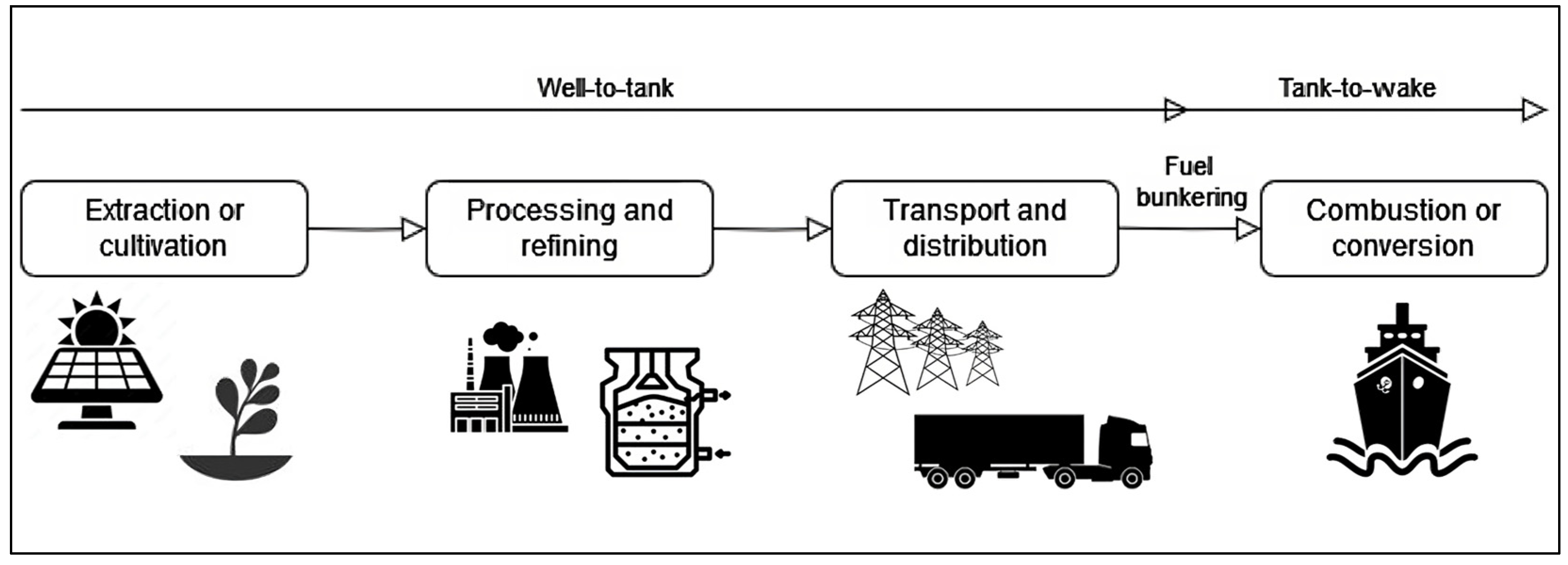
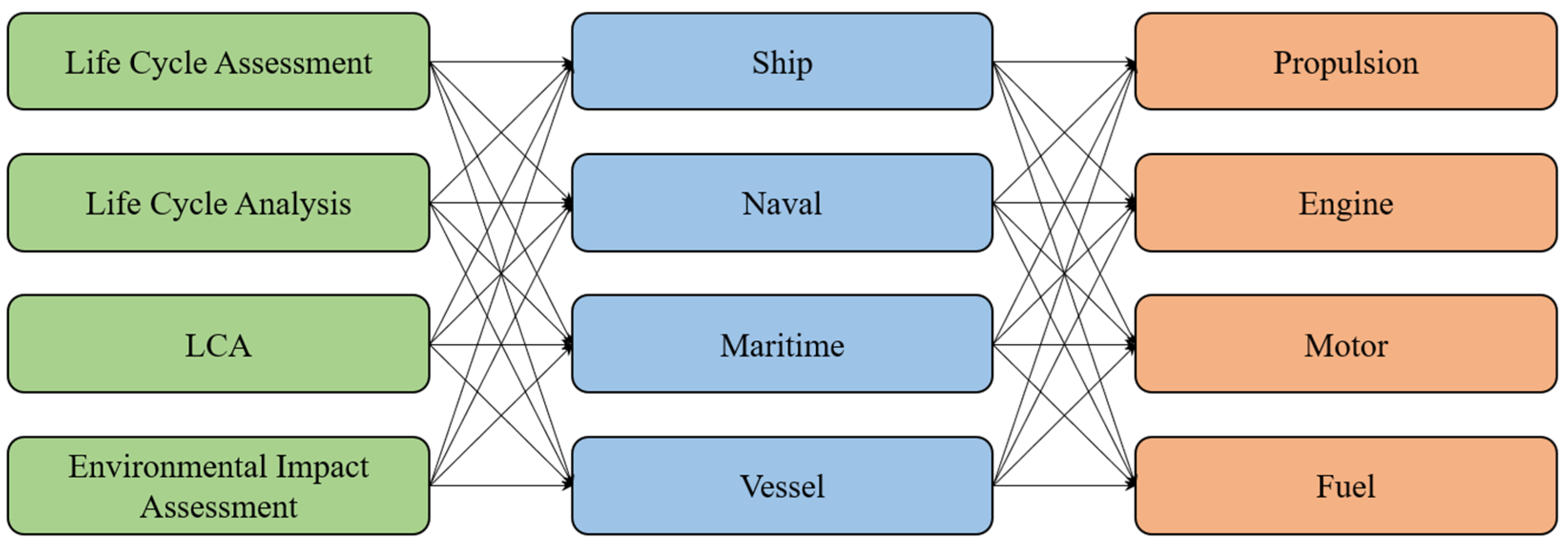
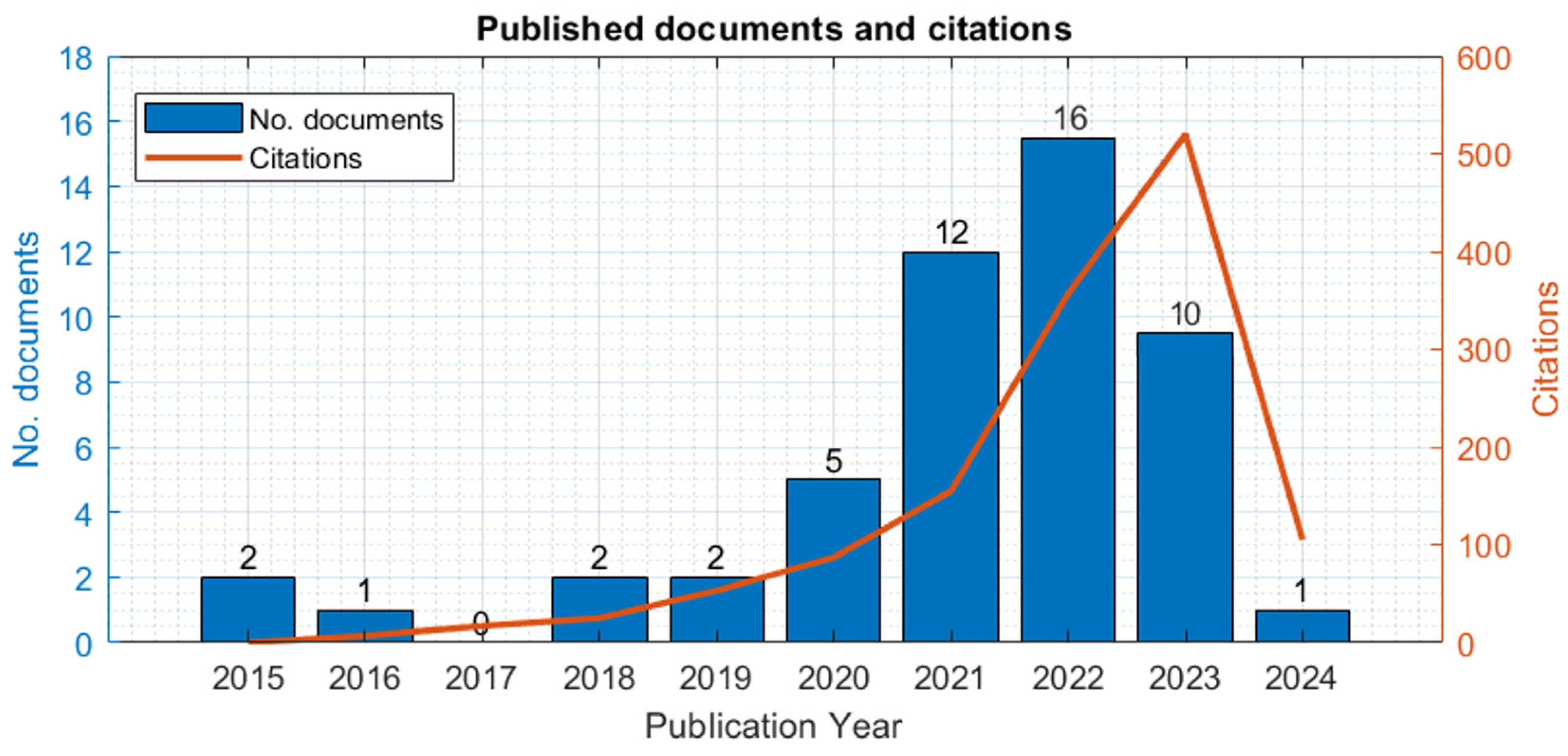
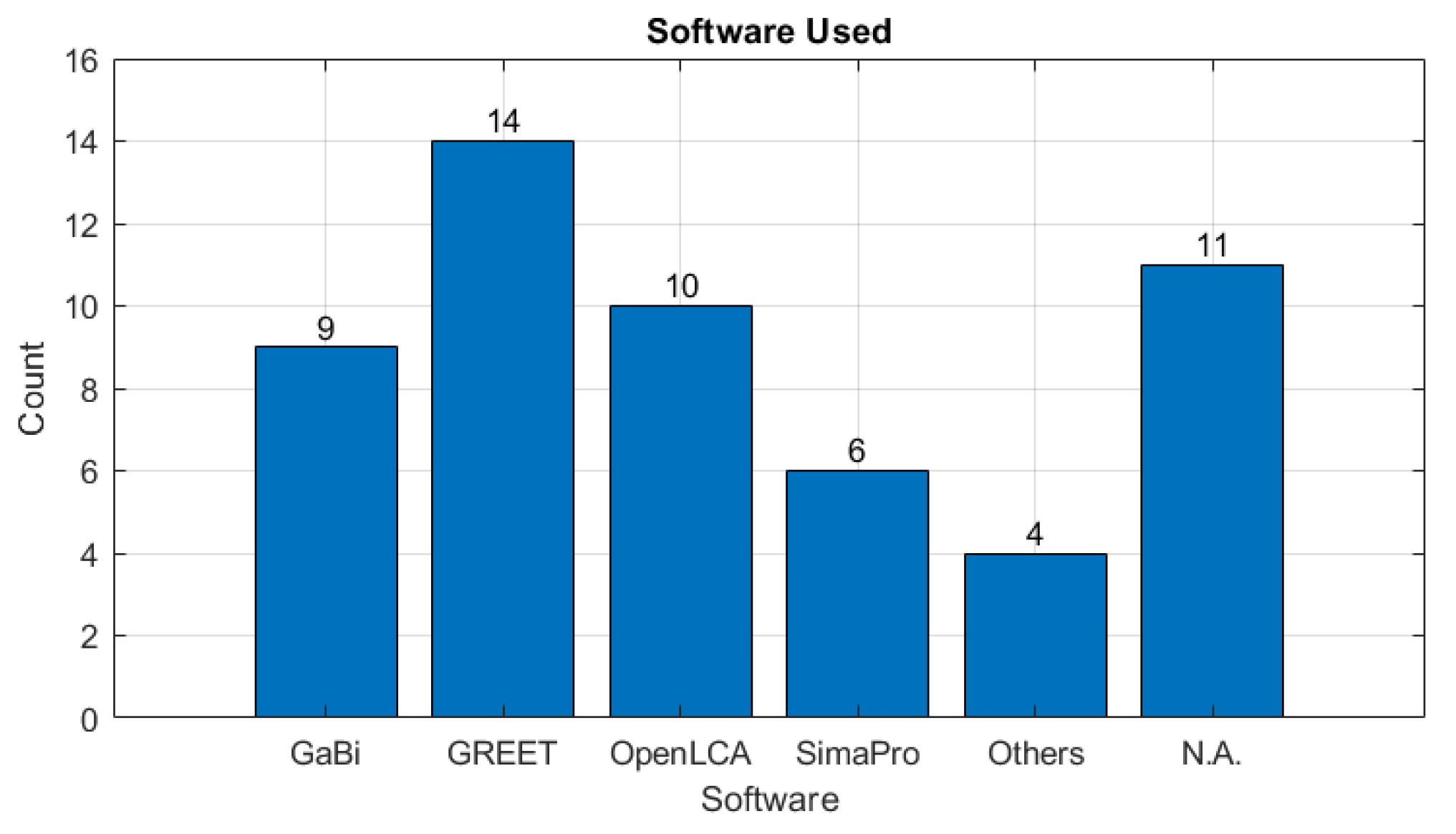
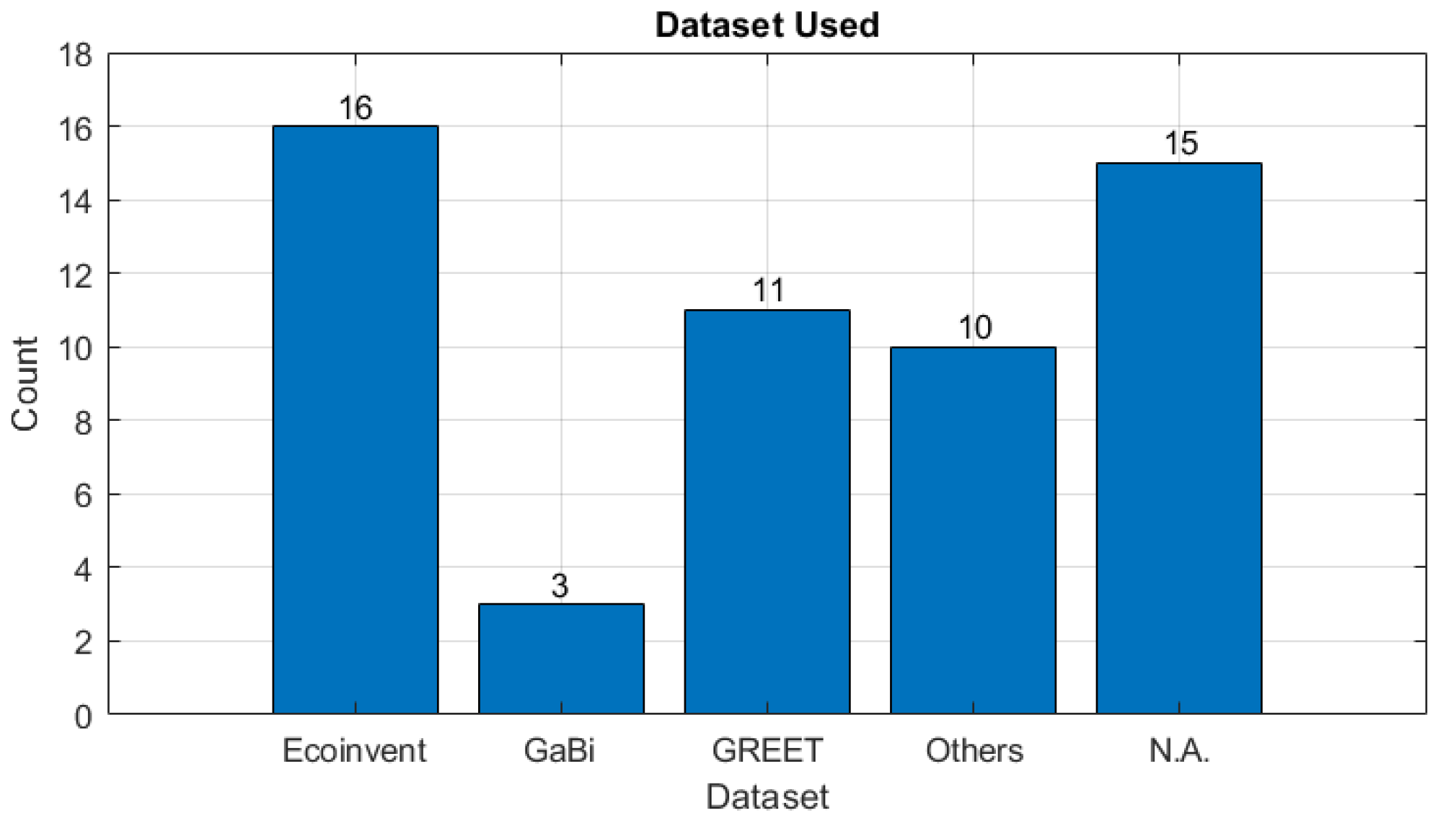
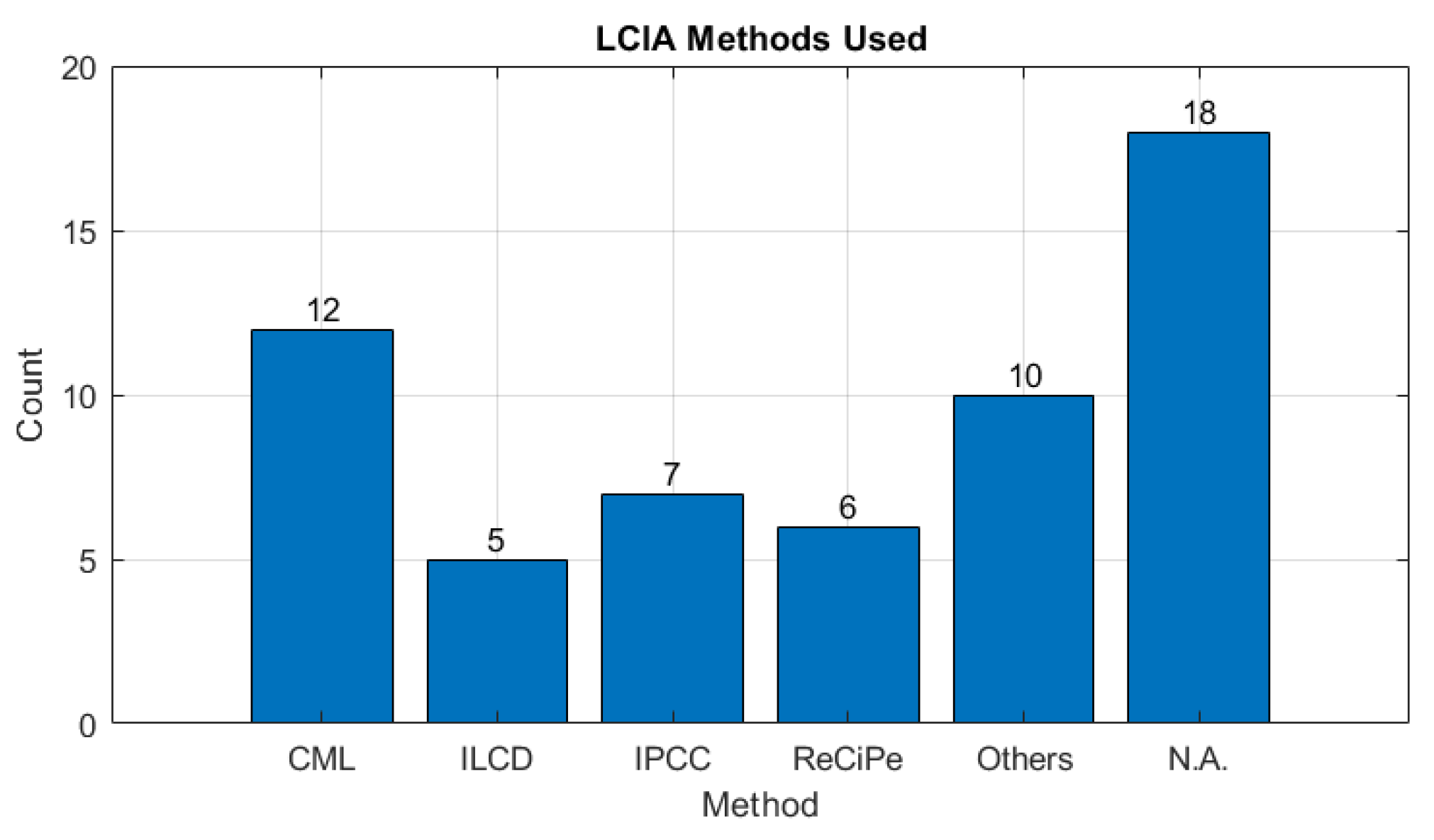
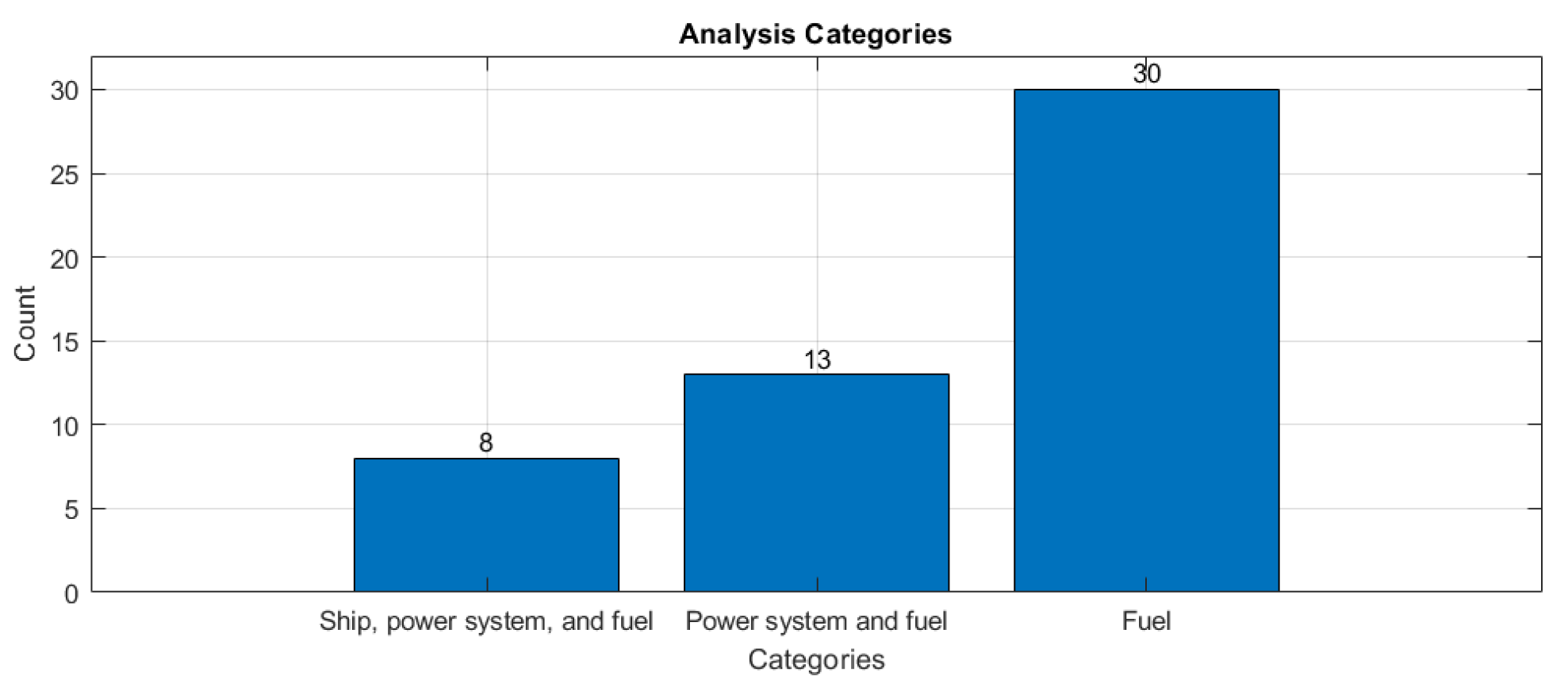
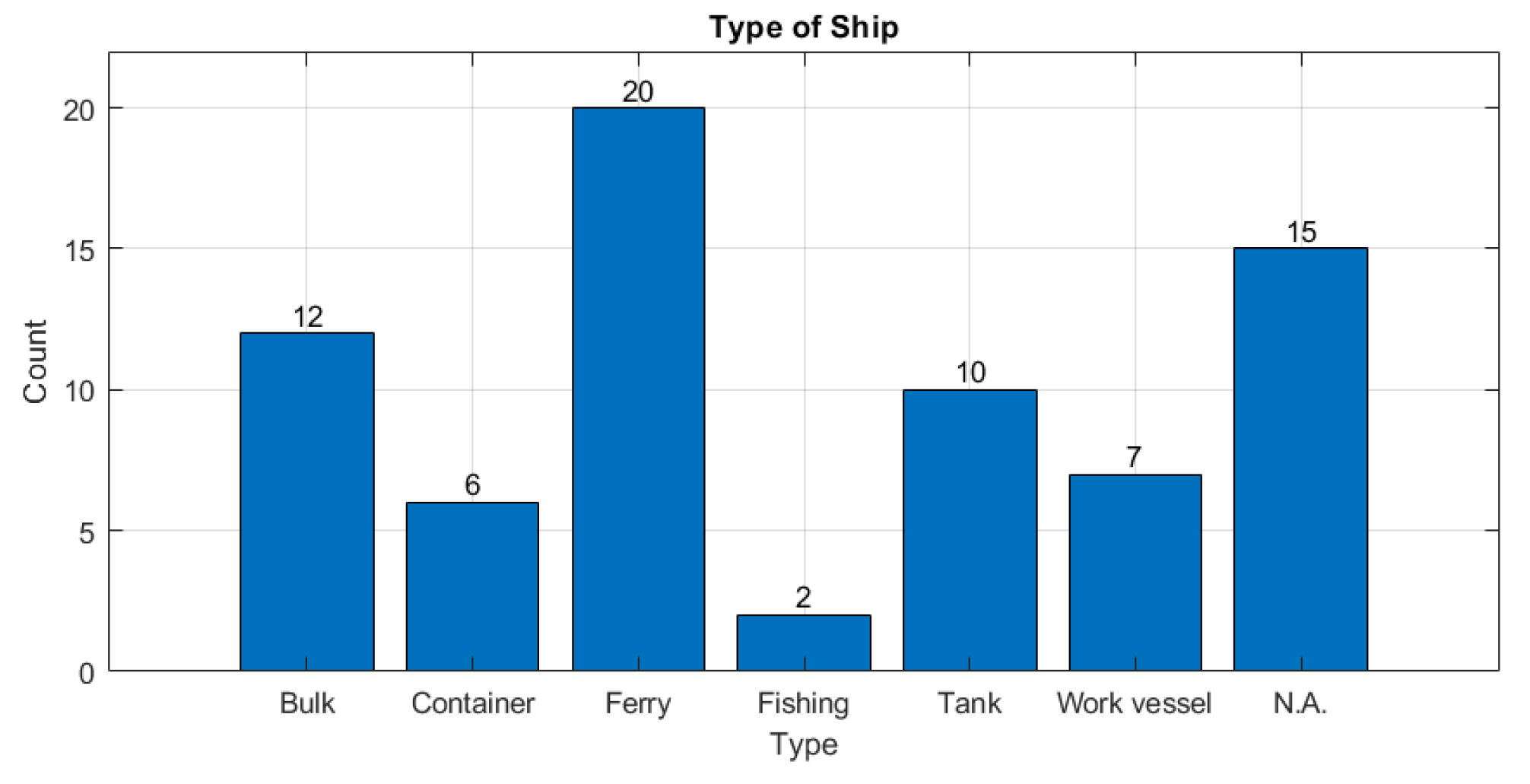

| Keywords Combination | Life-Cycle Assessment | |||||||||||||||
|---|---|---|---|---|---|---|---|---|---|---|---|---|---|---|---|---|
| Ship | Naval | Maritime | Vessel | |||||||||||||
| Propulsion | Engine | Motor | Fuel | Propulsion | Engine | Motor | Fuel | Propulsion | Engine | Motor | Fuel | Propulsion | Engine | Motor | Fuel | |
| No. Documents | 52 | 78 | 10 | 163 | 9 | 8 | 5 | 11 | 18 | 32 | 2 | 87 | 24 | 52 | 13 | 130 |
| Article | 33 | 53 | 6 | 118 | 3 | 3 | 1 | 6 | 13 | 23 | 1 | 64 | 16 | 30 | 4 | 85 |
| Conference Paper | 14 | 11 | 2 | 27 | 3 | 2 | 2 | 3 | 2 | 1 | 0 | 13 | 6 | 11 | 4 | 31 |
| Book Chapter | 2 | 10 | 0 | 5 | 0 | 0 | 0 | 0 | 2 | 1 | 0 | 4 | 1 | 1 | 0 | 5 |
| Review | 3 | 4 | 2 | 12 | 3 | 3 | 2 | 2 | 1 | 7 | 1 | 5 | 1 | 10 | 5 | 9 |
| Other | 0 | 0 | 0 | 1 | 0 | 0 | 0 | 0 | 0 | 0 | 0 | 1 | 0 | 0 | 0 | 0 |
| Tot. | 694 | |||||||||||||||
| Keywords Combination | Life-Cycle Analysis | |||||||||||||||
|---|---|---|---|---|---|---|---|---|---|---|---|---|---|---|---|---|
| Ship | Naval | Maritime | Vessel | |||||||||||||
| Propulsion | Engine | Motor | Fuel | Propulsion | Engine | Motor | Fuel | Propulsion | Engine | Motor | Fuel | Propulsion | Engine | Motor | Fuel | |
| No. Documents | 96 | 119 | 23 | 190 | 23 | 15 | 8 | 18 | 25 | 40 | 2 | 73 | 53 | 74 | 22 | 167 |
| Article | 52 | 67 | 8 | 135 | 9 | 7 | 2 | 8 | 15 | 26 | 1 | 56 | 24 | 36 | 8 | 90 |
| Conference Paper | 33 | 27 | 9 | 40 | 10 | 4 | 4 | 8 | 6 | 4 | 0 | 11 | 22 | 19 | 6 | 63 |
| Book Chapter | 2 | 3 | 0 | 2 | 0 | 0 | 0 | 0 | 1 | 1 | 0 | 3 | 1 | 2 | 0 | 3 |
| Review | 9 | 22 | 6 | 13 | 4 | 4 | 2 | 2 | 3 | 9 | 1 | 3 | 6 | 17 | 8 | 10 |
| Other | 0 | 0 | 0 | 0 | 0 | 0 | 0 | 0 | 0 | 0 | 0 | 0 | 0 | 0 | 0 | 1 |
| Tot. | 948 | |||||||||||||||
| Keywords Combination | LCA | |||||||||||||||
|---|---|---|---|---|---|---|---|---|---|---|---|---|---|---|---|---|
| Ship | Naval | Maritime | Vessel | |||||||||||||
| Propulsion | Engine | Motor | Fuel | Propulsion | Engine | Motor | Fuel | Propulsion | Engine | Motor | Fuel | Propulsion | Engine | Motor | Fuel | |
| No. Documents | 25 | 44 | 5 | 93 | 1 | 3 | 1 | 2 | 12 | 20 | 1 | 47 | 15 | 26 | 2 | 78 |
| Article | 16 | 33 | 5 | 75 | 0 | 1 | 0 | 1 | 8 | 15 | 1 | 34 | 11 | 19 | 1 | 67 |
| Conference Paper | 6 | 8 | 0 | 13 | 0 | 0 | 0 | 0 | 2 | 2 | 0 | 8 | 4 | 7 | 1 | 6 |
| Book Chapter | 1 | 1 | 0 | 3 | 0 | 0 | 0 | 0 | 1 | 2 | 0 | 3 | 0 | 0 | 0 | 4 |
| Review | 2 | 2 | 0 | 1 | 1 | 1 | 1 | 1 | 1 | 1 | 0 | 1 | 0 | 0 | 0 | 1 |
| Other | 0 | 0 | 0 | 1 | 0 | 1 | 0 | 0 | 0 | 0 | 0 | 1 | 0 | 0 | 0 | 0 |
| Tot. | 375 | |||||||||||||||
| Keywords Combination | Environmental Impact Assessment | |||||||||||||||
|---|---|---|---|---|---|---|---|---|---|---|---|---|---|---|---|---|
| Ship | Naval | Maritime | Vessel | |||||||||||||
| Propulsion | Engine | Motor | Fuel | Propulsion | Engine | Motor | Fuel | Propulsion | Engine | Motor | Fuel | Propulsion | Engine | Motor | Fuel | |
| No. Documents | 86 | 115 | 18 | 257 | 11 | 8 | 2 | 18 | 28 | 44 | 7 | 131 | 45 | 80 | 11 | 191 |
| Article | 51 | 75 | 13 | 186 | 6 | 3 | 1 | 7 | 17 | 31 | 4 | 98 | 25 | 47 | 7 | 127 |
| Conference Paper | 23 | 24 | 3 | 48 | 3 | 1 | 1 | 5 | 7 | 8 | 1 | 20 | 14 | 16 | 0 | 38 |
| Book Chapter | 4 | 4 | 0 | 5 | 0 | 0 | 0 | 0 | 1 | 1 | 0 | 4 | 3 | 2 | 0 | 4 |
| Review | 8 | 12 | 2 | 17 | 2 | 4 | 0 | 6 | 3 | 4 | 2 | 9 | 3 | 14 | 4 | 21 |
| Other | 0 | 0 | 0 | 1 | 0 | 0 | 0 | 0 | 0 | 0 | 0 | 0 | 0 | 1 | 0 | 1 |
| Tot. | 1052 | |||||||||||||||
| Reference | Boundaries | Ship Type |
|---|---|---|
| Trillos et al. [55] (2021) | WtW (Ship, power system, and fuel) | RoPax Ferry |
| Kanchiralla et al. [56] (2022) | WtW (Power system and fuel) | RoPax Ferry |
| Wang et al. [57] (2021) | CtG (Power system, and fuel) | Short-route ferry |
| Zincir et Arslanoglu [58] (2023) | WtW (Fuel) | Ocean tanker model |
| Seyam et al. [59] (2023) | WtT (Fuel) | Tank |
| Bicer and Dincer [60] (2017) | CtG (Ship, power system, and fuel) | Tank and freight ship |
| Fernández-Ríos et al. [61] (2022) | CtG (Power system and fuel) | N.A. |
| Ahmed et al. [62] (2023) | CtG (Ship, power system, and fuel) | Tank |
| Hwang et al. [63] (2020) | WtT, TtW, and WtW | Coastal ferry |
| Al-Aboosi et al. [64] (2021) | WtT and TtW | N.A. |
| Yacout et al. [65] (2021) | WtW (Fuel) | N.A. |
| Park et al. [66] (2022) | WtW (Fuel) | Short-route ferry |
| Wang et al. [67] (2022) | WtW and TtW (Fuel) | Super Yacht |
| Cucinotta et al. [68] (2021) | CtG (Ship, power system, and fuel) | Cruise ferry |
| Perčić et al. [69] (2021) | WtW (Power system and fuel) | Cargo, passenger, and dredger |
| Balcombe et al. [70] (2021) | WtW (Fuel) | N.A. |
| Taghavifar and Perera [71] (2022) | WtW (Fuel) | Tank |
| Manouchehrinia et al. [72] (2020) | WtW (Fuel) | Ferry |
| Malmgren et al. [73] (2021) | WtW (Fuel) | Ro-Pax |
| Jang et al. [74] (2021) | WtT and TtW (Fuel) | Bulk, container, tank, and Ro-Ro |
| Perčić et al. [75] (2022) | WtT and TtW (Power system and fuel) | Ro-Ro passenger |
| Bilgili [76] (2021) | WtT, TtW, and WtW (Fuel) | N.A. |
| Barbosa Watanabe et al. [77] (2022) | WtW (Fuel) | N.A. |
| Lee et al. [78] (2022) | WtT, WtW, and WtW (Fuel) | Ferry |
| Dong and Cai [79] (2018) | CtG (Ship, power system, and fuel) | Bulk |
| Ling-Chin and Roskilly [80] (2016) | CtG (Power system and fuel) | Ro-Ro cargo |
| Wang et al. [81] (2019) | CtG (Power system and fuel) | Ferry |
| Chen and Lee Lam [82] (2022) | CtG (Power system and fuel) | Tugboat |
| Tsang et al. [83] (2015) | WtT (Fuel) | N.A. |
| Huang et al. [84] (2022) | WtT and TtW (Fuel) | Tank |
| Sharafian et al. [85] (2019) | WtT and TtW (Fuel) | N.A. |
| Taghavifar and Perera [86] (2023) | WtT and TtW (Fuel) | N.A. |
| Seithe et al. [87] (2020) | WtW (Fuel) | Container, cruise, tanker, Ro-Pax |
| Perčić et al. [88] (2020) | WtW (Power system and fuel) | Ro-Pax |
| Wang et al. [89] (2023) | CtG (Ship, power system, and fuel) | Ferry, pelagic trawler, and tug |
| Gilbert et al. [90] (2017) | WtT and TtW (Fuel) | N.A. |
| Krantz et al. [91] (2023) | WtW (Fuel) | N.A. |
| Knight et al. [92] (2023) | WtT and TtW (Power system and fuel) | Ferry |
| Zincir [93] (2022) | WtT and TtW (Fuel) | General cargo |
| Thomson et al. [5] (2015) | WtW (Fuel) | Container and tug |
| Masum et al. [94] (2023) | WtW (Fuel) | N.A. |
| Tomos et al. [95] (2023) | WtW (Ship, power system, and fuel) | Tank, bulk, general cargo, container, and offshore vessels |
| Chalaris et al. [96] (2022) | WtW (Fuel) | Bulk |
| Zhang et al. [97] (2022) | WtW (Ship, power system, and fuel) | Bulk, container, and general cargo |
| Al-Douri et al. [98] (2021) | WtW (Fuel) | Tank, container, bulk, and general cargo |
| Taghavifar et al. [99] (2023) | WtT and TtW (Fuel) | N.A. |
| Yan et al. [100] (2022) | WtT and TtW (Power system and fuel) | Bulk |
| Mestemaker et al. [101] (2020) | CtG (Power system and fuel) | N.A. |
| Bilgili [102] (2021) | WtW (Fuel) | N.A. |
| Koričan et al. [103] (2022) | WtT and TtW (Fuel) | Fishing |
| Kim et al. [104] (2023) | WtT and TtW (Power system and fuel) | Fishing |
| Ref. | Fuel and Scenario | Engine Power (kW) | WtW (kg CO2 Eq.) | Normalized Emissions (kg CO2-Eq./kW × Year) |
|---|---|---|---|---|
| [63] | MGO | 4000.0 | 2.36 × 108 | 2.25 × 103 |
| LNG | 2.28 × 108 | 2.44 × 103 | ||
| Hydrogen (from LNG and coal power) | 3.27 × 108 | 4.09 × 103 | ||
| Hydrogen (from LNG and Nuclear Energy (SMR)) | 2.13 × 108 | 2.66 × 103 | ||
| Hydrogen (from LNG and Renewable) Energy (SMR) | 2.14 × 108 | 2.68 × 103 | ||
| Hydrogen (from LNG and Electricity (SMR)) | 2.77 × 108 | 3.46 × 103 | ||
| [67] | MGO | 4486.0 | 2.05 × 107 | 1.83 × 102 |
| LNG | 2.20 × 107 | 1.96 × 102 | ||
| Methanol (from NG) | 2.10 × 107 | 1.87 × 102 | ||
| Biomethanol | 4.31 × 106 | 3.84 × 10 | ||
| Biodiesel (Soy) | 1.66 × 107 | 1.48 × 102 | ||
| Hydrogen (SMR) | 2.25 × 107 | 2.00 × 102 | ||
| Hydrogen (Alkaline Water Electrolysis) | 1.24 × 106 | 1.11 × 10 | ||
| [68] | HFO | 24,000.0 | 1.39 × 108 | 2.32 × 102 |
| LNG | 22,400.0 | 8.35 × 108 | 1.49 × 103 | |
| [75] | Eurodiesel Blue | 876.0 | 4.40 × 106 | 2.51 × 102 |
| Electricity (Li-ion Battery) | 2.29 × 106 | 1.31 × 102 | ||
| Eurodiesel Blue | 2604 | 4.30 × 107 | 8.26 × 102 | |
| Electricity (Li-ion Battery) | 2.21 × 107 | 4.24 × 102 | ||
| Eurodiesel Blue | 5544.0 | 1.44 × 108 | 1.30 × 103 | |
| Electricity (Li-ion Battery) | 7.50 × 107 | 6.76 × 102 | ||
| [78] | MGO | 1080.0 | 3.05 × 107 | 1.41 × 103 |
| LNG | 3.02 × 107 | 1.40 × 103 | ||
| Hydrogen | 1200.0 | 3.37 × 107 | 1.40 × 103 | |
| [81] | Diesel—Without solar panel | 1268.0 | 5.75 × 107 | 1.81 × 103 |
| Diesel—With solar panel | 5.47 × 107 | 1.73 × 103 | ||
| [88] | Eurodiesel Blue | 876.0 | 4.40 × 106 | 2.51 × 102 |
| Electricity (Li-ion Battery) | 2.29 × 106 | 1.31 × 102 | ||
| Methanol | 3.04 × 106 | 1.73 × 102 | ||
| LNG | 4.02 × 106 | 2.30 × 102 | ||
| Eurodiesel Blue | 2604.0 | 4.30 × 107 | 8.26 × 102 | |
| Electricity (Li-ion Battery) | 2.21 × 107 | 4.24 × 102 | ||
| Methanol | 2.99 × 107 | 5.74 × 102 | ||
| LNG | 3.96 × 107 | 7.61 × 102 | ||
| Eurodiesel Blue | 5544.0 | 1.44 × 108 | 1.30 × 102 | |
| Electricity (Li-ion Battery) | 7.50 × 107 | 6.76 × 102 | ||
| Methanol | 9.82 × 107 | 8.86 × 102 | ||
| LNG | 1.30 × 108 | 1.17 × 103 |
| Ref. | Fuel and Scenario | Engine Power (kW) | WtW (kg CO2 Eq.) | Normalized Emissions (kg CO2-Eq./kW × Year) |
|---|---|---|---|---|
| [79] | HFO (P20) | 8830.0 | 3.04 × 107 | 1.72 × 102 |
| LSHFO (P20) | 2.88 × 107 | 1.63 × 102 | ||
| HFO (P30) | 3.11 × 107 | 1.17 × 102 | ||
| LSHFO (P30) | 2.95 × 107 | 1.11 × 102 | ||
| [93] | MDO | 2940.0 | 2.94 × 106 | 1.00 × 103 |
| 40% MDO—60% ammonia (from coal) | 5.51 × 106 | 1.87 × 103 | ||
| 40% MDO—60% ammonia (from oil) | 3.76 × 106 | 1.28 × 103 | ||
| 40% MDO—60% ammonia (from NG) | 2.89 × 106 | 9.83 × 102 | ||
| 40% MDO—60% ammonia (from NG + CCS) | 2.15 × 106 | 7.31 × 102 | ||
| 40% MDO—60% ammonia (from solar) | 2.10 × 106 | 7.14 × 102 | ||
| 40% MDO—60% ammonia (from wind) | 1.47 × 106 | 5.01 × 102 | ||
| 5% MDO—95% ammonia (from coal) | 7.00 × 106 | 2.38 × 103 | ||
| 5% MDO—95% ammonia (from oil) | 4.24 × 106 | 1.44 × 103 | ||
| 5% MDO—95% ammonia (from NG) | 2.86 × 106 | 9.71 × 102 | ||
| 5% MDO—95% ammonia (from NG + CCS) | 1.68 × 106 | 5.73 × 102 | ||
| 5% MDO—95% ammonia (from solar) | 1.61 × 106 | 5.46 × 102 | ||
| 5% MDO—95% ammonia (from wind) | 6.12 × 105 | 2.08 × 102 | ||
| [99] | LSD | 1346.8 | 1.81 × 106 | 1.34 × 103 |
| LNG | 1.52 × 106 | 1.13 × 103 | ||
| CH4 + LNG (S1) | 1.50 × 106 | 1.11 × 103 | ||
| CO2 sequestration from H2 gas production from NG: carbon capture (S2) | 1.41 × 106 | 1.05 × 103 | ||
| LNG + electricity (S3) | 1.48 × 106 | 1.10 × 103 | ||
| S4 | 1.56 × 106 | 1.15 × 103 | ||
| LNG 90% + Diesel 10% (T1) | 1.48 × 106 | 1.10 × 103 | ||
| LNG 90% + Diesel 10% (T2) | 1.48 × 106 | 1.10 × 103 | ||
| LNG 90% + Diesel 10% (T3) | 1.51 × 106 | 1.12 × 103 |
| Ref. | Fuel and Scenario | Engine Power (kW) | WtW (kg CO2 Eq.) | Normalized Emissions (kg CO2-Eq./kW × Year) |
|---|---|---|---|---|
| [84] | MGO | 22,000.0 | 8.91 × 107 | 4.05 × 103 |
| LNG | 7.25 × 107 | 3.29 × 103 | ||
| Methanol (from coal) | 2.16 × 108 | 9.80 × 103 | ||
| Methanol (from NG) | 1.12 × 108 | 5.09 × 103 | ||
| Methanol (from partial solar) | 1.21 × 108 | 5.51 × 103 | ||
| Methanol (from full solar and battery) | 5.86 × 104 | 2.66 × 100 | ||
| Ammonia (from coal) | 2.36 × 108 | 1.07 × 104 | ||
| Ammonia (from NG) | 1.79 × 108 | 8.14 × 103 | ||
| Ammonia (from full solar and battery) | 6.66 × 107 | 3.03 × 103 | ||
| MGO | 15,400.0 | 1.62 × 108 | 1.05 × 104 | |
| LNG | 8.46 × 107 | 5.49 × 103 | ||
| Methanol (from coal) | 6.75 × 107 | 4.38 × 103 | ||
| Methanol (from NG) | 5.49 × 107 | 3.56 × 103 | ||
| Methanol (from partial solar) | 9.14 × 107 | 5.94 × 103 | ||
| Methanol (from full solar and battery) | 4.49 × 107 | 2.92 × 103 | ||
| Ammonia (from coal) | 1.79 × 105 | 1.16 × 101 | ||
| Ammonia (from NG) | 1.30 × 108 | 8.41 × 103 | ||
| Ammonia (from full solar and battery) | 5.23 × 107 | 3.40 × 103 |
| Ref. | Fuel and Scenario | Engine Power (Kw) | WtW (kg CO2 Eq.) | Normalized Emissions (kg CO2-Eq./kW × Year) |
|---|---|---|---|---|
| [82] | Diesel | 3736.0 | 5.46 × 107 | 7.31 × 102 |
| Hydrogen | 3260.8 | 8.07 × 106 | 1.24 × 102 |
| Ref. | Fuel and Scenario | Engine Power (kW) | WtW (kg CO2 Eq.) | Normalized Emissions (kg CO2-Eq./kW × Year) |
|---|---|---|---|---|
| [103] | MDO | 223.0 | 4.61 × 106 | 1.03 × 103 |
| Electricity | 2.87 × 106 | 6.44 × 102 | ||
| Methanol | 3.39 × 106 | 7.60 × 102 | ||
| LNG | 2.93 × 106 | 6.58 × 102 | ||
| Ammonia | 8.35 × 106 | 1.87 × 103 | ||
| B20 | 3.78 × 106 | 8.46 × 102 | ||
| Hydrogen | 3.65 × 106 | 8.19 × 102 | ||
| [104] | Gasoline (Coastal) | 186.0 | 1.15 × 106 | 2.06 × 102 |
| MDO (Coastal) | 1.20 × 106 | 2.15 × 102 | ||
| LPG (Coastal) | 8.25 × 105 | 1.48 × 102 | ||
| CPO (Coastal) | 3.33 × 105 | 5.97 × 101 | ||
| BRD (Coastal) | 3.88 × 105 | 6.95 × 101 | ||
| MDO (Offshore) | 1.85 × 106 | 3.32 × 102 | ||
| LPG (Offshore) | 1.29 × 106 | 2.30 × 102 | ||
| CPO (Offshore) | 5.45 × 105 | 9.77 × 101 | ||
| BRD (Offshore) | 6.27 × 105 | 1.12 × 102 | ||
| Gasoline (Other) | 1.75 × 106 | 3.14 × 102 | ||
| MDO (Other) | 2.00 × 106 | 3.58 × 102 | ||
| LPG (Other) | 1.37 × 106 | 2.46 × 102 | ||
| CPO (Other) | 5.45 × 105 | 9.76 × 101 | ||
| BRD (Other) | 6.37 × 105 | 1.14 × 102 |
| Fuel | Normalized Emissions Magnitude Range (kg CO2-Eq./kW × Year) |
|---|---|
| 40% MDO e 60% Ammonia | 102–103 |
| Ammonia | 101–104 |
| B20 | 102–102 |
| Biodiesel (Soy) | 102–102 |
| BRD | 101–102 |
| CPO | 101–101 |
| Electricity | 102–102 |
| Eurodiesel Blue | 102–103 |
| Gasoline | 102–102 |
| HFO | 102–103 |
| Hydrogen | 101–103 |
| LNG | 102–103 |
| LNG Hybrid (Electricity) | 103–103 |
| LPG | 102–102 |
| LSD | 103–103 |
| LSHFO | 102–102 |
| MDO | 103–103 |
| Methanol | 100–103 |
| MGO | 102–104 |
Disclaimer/Publisher’s Note: The statements, opinions and data contained in all publications are solely those of the individual author(s) and contributor(s) and not of MDPI and/or the editor(s). MDPI and/or the editor(s) disclaim responsibility for any injury to people or property resulting from any ideas, methods, instructions or products referred to in the content. |
© 2024 by the authors. Licensee MDPI, Basel, Switzerland. This article is an open access article distributed under the terms and conditions of the Creative Commons Attribution (CC BY) license (https://creativecommons.org/licenses/by/4.0/).
Share and Cite
Cucinotta, F.; Barberi, E.; Salmeri, F. A Review on Navigating Sustainable Naval Design: LCA and Innovations in Energy and Fuel Choices. J. Mar. Sci. Eng. 2024, 12, 520. https://doi.org/10.3390/jmse12030520
Cucinotta F, Barberi E, Salmeri F. A Review on Navigating Sustainable Naval Design: LCA and Innovations in Energy and Fuel Choices. Journal of Marine Science and Engineering. 2024; 12(3):520. https://doi.org/10.3390/jmse12030520
Chicago/Turabian StyleCucinotta, Filippo, Emmanuele Barberi, and Fabio Salmeri. 2024. "A Review on Navigating Sustainable Naval Design: LCA and Innovations in Energy and Fuel Choices" Journal of Marine Science and Engineering 12, no. 3: 520. https://doi.org/10.3390/jmse12030520
APA StyleCucinotta, F., Barberi, E., & Salmeri, F. (2024). A Review on Navigating Sustainable Naval Design: LCA and Innovations in Energy and Fuel Choices. Journal of Marine Science and Engineering, 12(3), 520. https://doi.org/10.3390/jmse12030520








